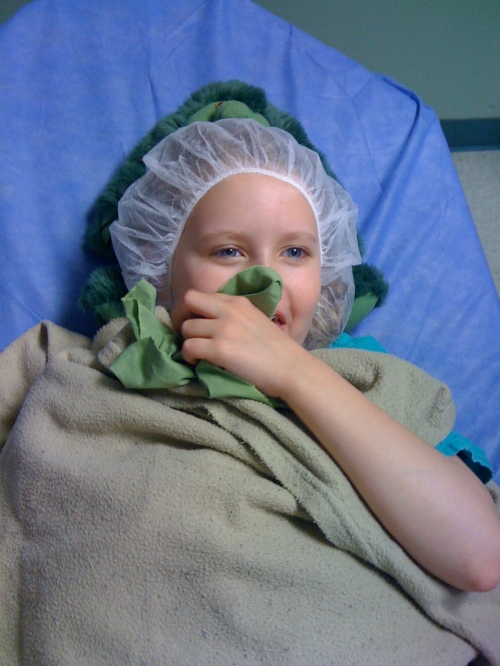Call me crazy… BUT I think we’re seeing some changes. Okay, I know, I said this after each of the three stem cell treatments. Though there really did seem to be a slight shift – a change in her speech, better eye contact, longer more complex sentences, a more grounded presence in the world and I don’t think we were wrong about any of that. I’m pretty sure Emma really did make some progress. However, here’s my latest theory (Richard, please refrain from rolling your eyes) – what if the stem cell treatments were helped by the fact that she also wasn’t eating all the dairy she normally ate. What if in addition to giving her a little boost, the fact that she ate very little and therefore almost no dairy and hardly any wheat contributed to the progress we saw? What if these food intolerances really are making it difficult for her to concentrate, focus, stay on task, carry on a conversation, maintain eye contact?
Today is the 6th day on Emma’s modified gluten free/casein free diet. I use the word modified because, according to Dr. D she can tolerate dairy products from sheep and goats. However she is not allowed to eat anything containing soy, corn or potato. Which pretty much eliminates all pre-made foods, no matter how organic and gluten free they are, they all, every single one of them, contain either soy, corn or potato and often all three. In addition she cannot eat anything with chicken eggs as she cannot have the whites, yolks are okay, but not the whites.
I’ve been doing a great deal of baking. Which is a bit ironic considering how little Emma is actually consuming, but I keep trying to find things she might like. I also love a challenge. My mother told me about one of those cooking shows she likes called Chopped or a name like that. I’ve never watched it, but she described how the chefs are given bizarre items such as (I can’t remember what the actual ingredients were on the episode she told me about, so I’m making this up) – sweetbreads, licorice and coca-cola – and told to create something edible. The chef then whips up some amazing concoction using those ingredients as their base, which looks delicious and the judges proclaim it a work of art.
The list of Emma’s “CANNOT EAT” foods sits on our kitchen counter, where I refer to it, reminding myself that if someone can prepare a fabulous dish with lifesavers and sweetbreads (or whatever it was they were given) then surely I can create something Emma will eat with all the foods she CAN have. Still it does seem daunting. And I’ll bet Emma wouldn’t touch any of those dishes prepared by those fabulous chefs, no matter how talented they may be. Emma is one discerning customer. Or as my son Nic said in answer to my question as to why he didn’t like the girl who keeps texting him at all hours of the day and night, “I’ve got very high standards, Mom.” He then went back to playing his video game, involving lots of blood, various weapons no one has ever heard of and screams of agony.
When I first told Richard about taking Emma to Dr. D, he asked, “So what’s the science behind this?”
And the truth is I cannot answer that. Though the following non-biased paragraph from the website, about.com is a pretty good description of the theory behind foods, intolerances, GI issues and autism:
“Why Does GFCF Seem to Work?
GFCF diets are difficult and expensive to administer. They require a lot of dedication and knowlege, and most professionals suggest that the diet be implemented over at least three months. Given all of this, it’s possible that parents who desperately want to see improvement could report improvement that may or may not actually be present. In addition, many children do gain new skills over the course of three months, with or without special diets.But there’s more to the story than just wishful thinking. Allergies to gluten and cassein are not uncommon, and those allergies often manifest themselves in diarrhea, constipation, bloating and other symptoms. About 19 to 20 percent of autistic children seem to have significant gastrointestinal issues.
If these issues are caused by gluten and/or cassein, then they would certainly be significantly improved by the diet. By removing a source of constant discomfort and anxiety, parents may well be opening the door to improved behaviors, better focus, and even lowered anxiety.”
It may be that I am trying to find improvements that have nothing to do with the change in her diet. It may be wishful thinking on my part. It may be that what I’m seeing may have happened had we not started her on this radical new diet. But I began this blog as an honest documentation of Emma, the progress, the lack of progress and everything in between. Since we began the diet I have seen the following:
Greater sustained eye contact. Less spaciness and a more solid grounded presence. An interest in her Dad and a desire to include him beyond what she normally displays. This morning, when I told her we didn’t have time to finish her study room and that we’d finish it tonight, she said, “Study room later. We get to show Daddy.” Now this may seem insignificant to most, but I can tell you, to Richard this sort of acknowledgement is a long time coming.
Emma – last night – October 20th, 2011
For more on Emma’s journey through a childhood of autism, go to: www.EmmasHopeBook.com









